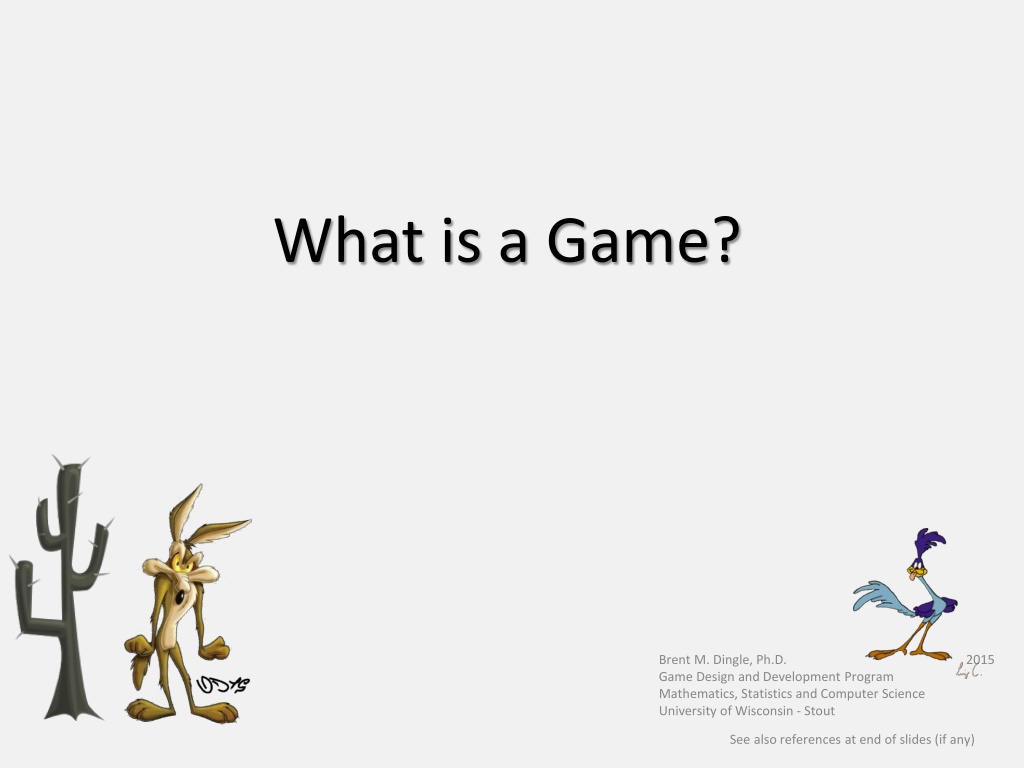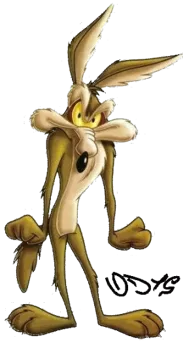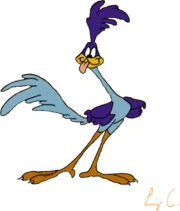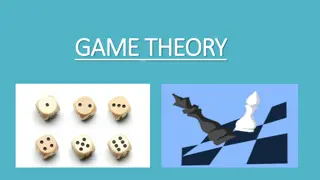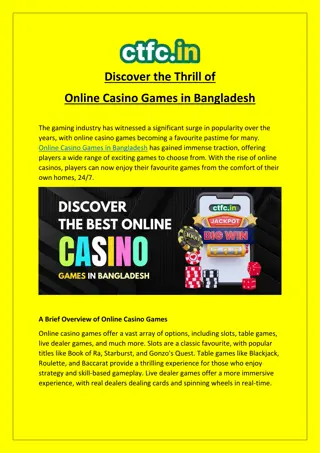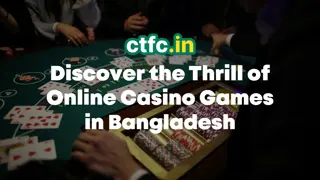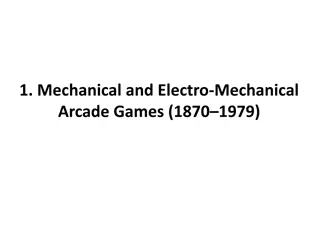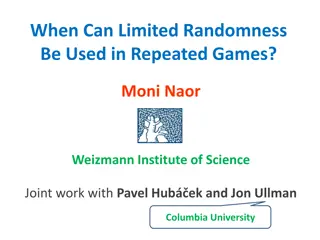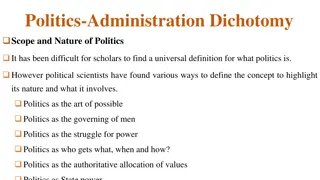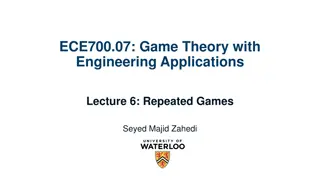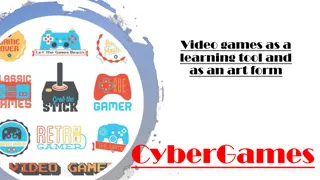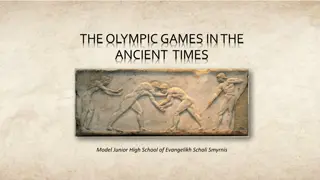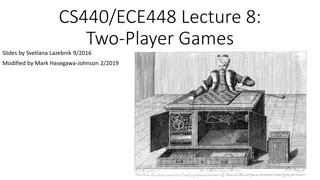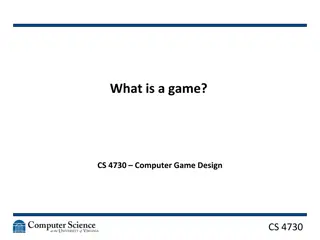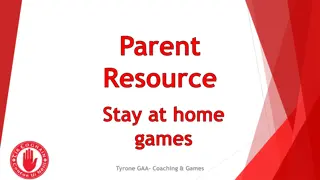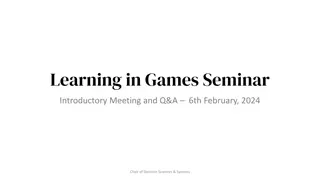The Essence of Games: Various Definitions Explored
Exploring the concept of games through multiple definitions provided by experts in the field. From defining games as activities with rules involving conflict to voluntary efforts to overcome obstacles, each definition sheds light on essential elements and characteristics of games, highlighting their diverse nature and significance in human interaction and entertainment.
Uploaded on Oct 10, 2024 | 0 Views
Download Presentation

Please find below an Image/Link to download the presentation.
The content on the website is provided AS IS for your information and personal use only. It may not be sold, licensed, or shared on other websites without obtaining consent from the author. Download presentation by click this link. If you encounter any issues during the download, it is possible that the publisher has removed the file from their server.
E N D
Presentation Transcript
What is a Game? Brent M. Dingle, Ph.D. Game Design and Development Program Mathematics, Statistics and Computer Science University of Wisconsin - Stout 2015 See also references at end of slides (if any)
A Definition A Game is a play activity with rules that involves conflict Problem? It says nothing about how to design a game
Formal Elements Perhaps easier to discuss a game in terms of its component parts rules resources actions story These may also be called formal elements of a game
How to Find the Parts Consider options
Definition 1 A game has ends and means an objective, an outcome, and a set of rules to get there David Parlett
Definition 2 A game is an activity involving player decisions, seeking objectives within a limiting context Clark C. Abt
Definition 3 A game has six properties it is free playing is optional and not obligatory separate fixed in space and time, in advance has an uncertain outcome is unproductive generates neither goods nor wealth is governed by rules is make believe not real life, but a shared separate reality Roger Callois
Definition 4 A game is a voluntary effort to overcome unnecessary obstacles Bernard Suits NOTE: this definition implies voluntary with goals and rules unnecessary implying inefficiency caused by rules on purpose
Definition 5 Games have 4 properties Closed formal system formal meaning defined Involve interaction Involve conflict Offer safety as compared to what they might fully represent Chris Crawford
Definition 6 Games are a form of art which the participants (players) make decisions to manage resources using game tokens in the pursuit of a goal Greg Costikyan
Definition 7 Games are a system in which players engage in an artificial conflict defined by rules that results in a quantifiable outcome i.e. there is winning and losing book: Rules of Play by Katie Salen and Eric Zimmerman which also lists all the above definitions
Common Elements Games (implicitly) have players Games are an activity Games have rules Games have conflict Games have goals Games involve decision making Games are artificial, safe, outside ordinary life Games involve no material gain on the part of the players Games are voluntary Games have an uncertain outcome Games are a representation or simulation of something real but are themselves make believe Games are inefficient Games have systems Games are a form of art
Observations on: Goals Part Object of the game is what? Players are trying to do what? Goals can help tie the parts of a game together Details Vary Some Generic Options Capture/Destroy Control Territory Collection Solve (like Clue) Chase/Race/Escape Build
Observations on: Story Part Games should have a story Narrative of the game Theme of the game Binds events, goals, objectives, parts together Moves player towards the completion of the game Options: Designer driven Emergent based on player choices and actions Linear Non-Linear
Observations on: Rules Part Rules and Mechanics of a game are tricky are subtle need details must be tested using mockups and prototypes by real players and designers and developers can bind parts of the game together should create/support player expectations
Observations on System Part Games have/are Systems a set of connected things or parts forming a complex whole a set of principles or procedures according to which something is done an entire group of parts that work together A good game ties all of its parts together
End Point of Element Parts Game Design is Designing a System of Elements Each element may influence another Changing one element may change the entire game The combination of elements forms a complex whole A system may be a system of systems a game containing games The game/system state is dependent on the state of its elements Allows for emergent behavior (from a simple rule set) Difficulty in predicting Player choices are variable and affect states mechanics yield system dynamics
Recall Designing a game is designing a system Game design and development is iterative Games can be described as the successive layering of constraints Games have elements
Another Set of Parts It is possible to look at a game in different ways depending on how you define parts The Mechanics, Dynamics, Aesthetics (MDA) Framework Has received a lot of attention from industry professionals Shows the designer perspective AND the player perspective How each sees and relates to the same game parts Aids the process of designing and developing a game Defined in 2001 by LeBlanc, Hunicke, and Zabek http://www.cs.northwestern.edu/~hunicke/MDA.pdf
Mechanics = Rules Mechanics are the rules of the game at the level of data representation and algorithms These Formal Rules define What is allowed (and not allowed) How is the game setup What actions can players perform What goals/objectives can/should/must be achieved When does the game end Who wins, who loses, what is scored How are rules enforced
Dynamics = System (in motion) Dynamics describe the run-time behavior of the mechanics acting on player inputs and each others outputs over time Describethe play of the game What strategies/behaviors emerge from the rules How do the players interact with the environment and each other
Aesthetics = Fun Aesthetics describes the desired emotional responses evoked in the player when interacting with the game system Not the visual elements of the game But rather the player experience of the game enjoyable, fun, frustrating, boring, interesting emotionally or intellectually engaging
Example: Pac Man Mechanic Ghost s pathfinding logic is defined by rules Each ghost has a unique seeking mechanic Blinky targets the tile player is in Inky targets the end of the vector that starts at Blinky, goes through two tiles in front of player is twice as long as distance of that tile to Blinky http://home.comcast.net/~jpittman2/pacman/pacmandossier.html
Example: Pac Man Dynamic The rules create a dynamic where the player is trapped by Blinky and Inky http://home.comcast.net/~jpittman2/pacman/pacmandossier.html
Example: Pac Man Dynamic The enemy dynamics challenge the player creating an aesthetic of fun and excitement http://home.comcast.net/~jpittman2/pacman/pacmandossier.html
Example: Spawn Points First-Person Shooters often have a Spawn Point Mechanic
Example: Spawn Points Leading to the dynamic where a player may sit near a spawn point and take out players as they respawn
Example: Spawn Points Leading to the Aesthetic of Player Frustration
Order of Thought This is the order a Designer will often experience/plan the game Designers control the mechanics Mechanics generate dynamics Dynamics generate aesthetics Designers often work outward design the mechanic to generate the desired aesthetic
Player View Players see things in reverse order Aesthetics set the tone which is created from observed dynamics which is controlled by operable mechanics
End Summary Games are composed of elements/parts Rules are a major part of a game Designers create rules Rules create gameplay Gameplay creates player experience A small rule change may have enormous (or no) effect Play Testing is critical Test early mockups, prototypes Test Often Evaluate Improve Iterate, Iterate, Iterate From Success to More Success
Questions? Beyond D2L Examples and information can be found online at: http://docdingle.com/teaching/gdd450/ Continue to more stuff as needed
References Some material in these slides was derived/based on material from: Ian Schreiber, Game Design Concepts https://gamedesignconcepts.wordpress.com/ Released under a Creative Commons Attribution 3.0 U.S. License http://creativecommons.org/licenses/by/3.0/us/ Matthew Gallant, Mechanics, Dynamics & Aesthetics Blog, August 21, 2009 http://gangles.ca/2009/08/21/mda/
